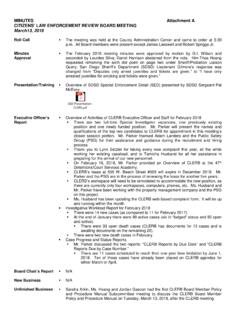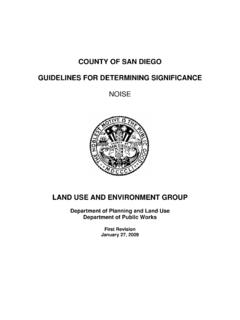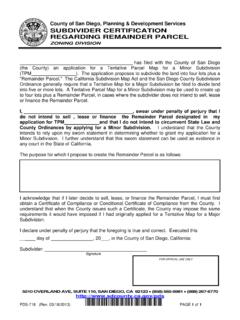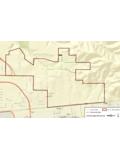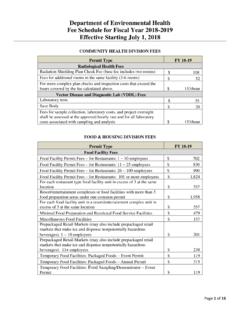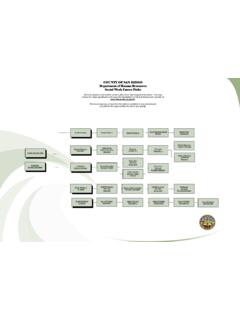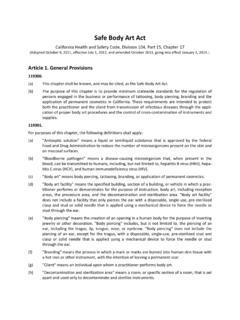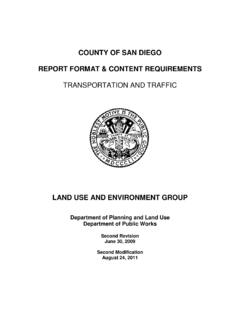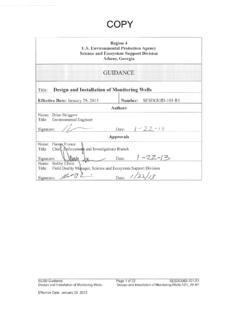Transcription of Boring and Well Permits 5-1 Soil and Rock …
1 SAM Manual 8/15/2011 Page 5-1 section 5 Site Investigation Techniques I. INTRODUCTION Consistent and appropriate site investigation techniques must be used to ensure that accurate, reliable, and representative data are collected during the site assessment process. The following guidance is provided to establish standardized methods and procedures for the investigation, testing, and interpretation of geology, hydrogeology, and contaminant mobility. This section is not intended to duplicate well -established methods and procedures, but to establish minimum standards for proper investigation techniques at a contaminated site. The investigation techniques include soil and rock sampling, soil vapor sampling, direct measurement of vapor flux, groundwater sampling, laboratory analysis, and stockpile sampling. Additional guidance on standard field and laboratory methods can also be found in many textbooks, government agency documents, and professional society publications.
2 II. Boring AND well Permits Permits are required for all groundwater, vadose wells, cathodic protection wells, and for many exploratory borings (San Diego County Code, Title 6, Division 4). Standards for well construction, destruction, reconstruction, or repair are as stated in California Department of Water Resources Bulletins 74-81 and 74-90. More specific Boring and well construction standards are presented in Appendix An explanation of permit requirements is provided below. Completed permit applications must be submitted to the San Diego County Department of Environmental Health (DEH), Monitoring well Program (MWP) and approval must be received before drilling can begin. In San Diego County, wells include: Community supply wells, Individual domestic wells, Commercial supply wells, Industrial supply wells, Agricultural supply wells, Cathodic protection wells, Groundwater monitoring wells (observation wells and piezometers), Groundwater remediation wells, Vadose monitoring wells, (vapor wells, gas monitoring wells, vapor probes), Vapor extraction/inlet wells, and In This section : Introduction 5-1 Boring and well Permits 5-1 Soil and Rock Sampling 5-8 Soil Vapor Sampling 5-15 Direct Measurement of Vapor Flux 5-42 well Development 5-43 well Purging and Sampling 5-45 Non-Aqueous Phase Liquids 5-60 Soil Leachability 5-65 Laboratory Analysis 5-67 Waste Characterization 5-76 section 5.
3 SITE INVESTIGATION TECHNIQUES Page 5-2 8/15/2011 SAM Manual Borings (test holes, auger holes, driven test holes, cone penetrometer test holes, Site Characterization and Analysis Penetrometer System [SCAPS] test holes, geotechnical borings, etc.). Geothermal Heat Exchange Wells Enhanced Leak Detection (ELD) Probes A. Permit Requirements 1. Groundwater, Vadose, and Cathodic Protection Wells well Permits are required for any groundwater, vadose, or cathodic protection well installation regardless of how the well is installed. Dewatering wells require a permit if they will be used beyond the initial construction phase. Information on the construction and destruction methods and specific permitting requirements for cathodic protection wells can be found on the San Diego County website at the MWP webpage: 2. Enhanced Leak Detection (ELD) Probes ELD is used to monitor new and existing underground and above ground storage tanks and associated pipelines for vapor and liquid leaks.
4 All vertical vapor probes installed after underground and above ground tanks and pipelines are in operation require a permit. For details about permitting and construction requirements, refer to Appendix B. 3. Exploratory or Test Borings and Geotechnical Borings well Permits are required on all sites for: Any Boring in which a casing will be installed Any Boring that has a monitoring device installed Any soil Boring greater than 20 feet in depth Any soil Boring , 20 feet or less in depth, where the groundwater table is anticipated to be encountered A permit for geotechnical borings may be waived after review of information on the location of the borings by the MWP. Waivers are considered only for areas where hazardous waste or hazardous materials have not been stored, are not now stored, are not proposed to be stored or areas where soil and groundwater contamination is not known or suspected. Submit a waiver request (available at the above referenced webpage) along with a detailed site map and a description of the proposed work to assist the MWP in the evaluation.
5 4. well Destruction well Permits are required for the destruction of any groundwater, vadose, or cathodic protection well unless the well is destroyed within the life of the permit. section 5: SITE INVESTIGATION TECHNIQUES SAM Manual 8/15/2011 Page 5-3 5. well Reconstruction well Permits are required for reconstruction of any groundwater, vadose, or cathodic protection well . A reconstruction is defined as an alteration to a well beyond minor modifications to the surface completion above the bentonite layer. Minor modifications may be completed without a permit but must be approved by the MWP before work begins . B. Permit Application Submit one original complete Permit Application for Groundwater and Vadose Monitoring Wells and Exploratory or Test Borings ( well / Boring application), detailed site plan, additional supporting documents (if required), and the appropriate fees to the Monitoring well Permit Desk. A copy of the well / Boring application is available in Appendix and on the above webpage.
6 The MWP will not process the application until all fees are submitted. The application must have original signatures of both the driller and the Professional Geologist (PG), Registered Civil Engineer (RCE), Certified Engineering Geologist (CEG), or Certified Hydrogeologist (CHG) in responsible charge of the work. Please allow seven to ten (7 to 10) working days after a complete application package is received for processing and review. If an incomplete application is submitted, the permit application may be returned. The approved permit will be emailed to the contact person indicated in the application and the driller. 1. Application for Groundwater Monitoring well Construction, Destruction, and Borings Complete the Permit Application for Groundwater and Vadose Monitoring Wells and Exploratory or Test Borings. The following information must be included on the application. a. Assessor s parcel number (APN) b. Current property owner c.
7 C57 driller's information (all work must be done by a properly California licensed driller with a bond to work in San Diego County.) d. Licensed Geologist or Civil Engineer on project e. Number of wells (or borings) to be constructed or destroyed f. well type g. drilling method h. Proposed materials to be used i. Proposed well construction or for well destructions, a copy of the well as built diagram or well construction permit number(s) j. Driller s signature (must have original signature) k. Original signature of Professional Geologist (PG), Registered Civil Engineer (RCE), Certified Engineering Geologist (CEG), or Certified Hydrogeologist (CHG) for wells and borings. The driller s signature must be provided for well destructions. l. Detailed site plan (drawn to scale) showing the location of the proposed well (s) and/or Boring (s) and the location of existing wells. The plan must show the location of existing improvements, such as structures, underground storage tanks (USTs), and underground utilities.
8 An adequate vicinity map is also required to show the site location in relation to the surrounding area. m. Supporting documents: Applications for traffic control Permits , and encroachment/excavation Permits section 5: SITE INVESTIGATION TECHNIQUES Page 5-4 8/15/2011 SAM Manual for work in the public right-of-way A Property Owner Consent (POC) form is required on applications for all work except: onsite, open LOP site assessment cases (SAM is lead agency), Caltrans property and Military property. 2. Application for Cathodic Protection Wells and ELD Probes All of the above information is required with the exception that only a driller s signature is required. 3. Fees To be accepted by the MWP, a well / Boring application must be submitted with the appropriate fees. The current permit fees are detailed on page three of the application that is provided on the monitoring well webpage. 4. Refund of Permit Fees If you did not complete the original scope of work for the permit issued, submit a written request to the Monitoring well Permit Desk for a refund of the appropriate portion of the unused fees.
9 Your request must be received within 30 days after the expiration date of the permit. A fee will be deducted from the refund to cover the processing and the technical review of the permit. 5. Permit Extensions A permit is valid for 120 days. It may be extended for an additional 120 days for the purpose of completing the original scope of work. Two extensions may be requested for 120 days each for the purpose of completing the original scope of work. Submit a written request for an extension to the Monitoring well Permit Desk before the expiration date, along with an extension fee. Contact the Monitoring well Desk for the amount of the fee as it is based on the Environmental Health Technician hourly rate. The maximum term of a permit cannot exceed 360 days. 6. Permit Modifications Permit modifications will be granted if the Monitoring well Permit Desk is notified at the time of initial drilling activities that further work is needed. We will require a written request for a modification, including the additional fees and a revised site map to be submitted to our office within five (5) business days.
10 If it is determined after the initial drilling that additional work is necessary, a new application must be submitted. section 5: SITE INVESTIGATION TECHNIQUES SAM Manual 8/15/2011 Page 5-5 C. Inspections 1. drilling Inspections The Monitoring well Permit Desk must be given 48 hours notice prior to commencement of drilling activity. MWP staff conduct random on-site drilling inspections. These inspections are to observe field activities and to ensure that all work is being completed in compliance with the current local and state requirements. 2. well Completion Inspections a. MWP staff will perform inspections of all sites that have groundwater, vadose, or cathodic protection wells, or where these wells have been destroyed, to determine if the wells were completed or destroyed in accordance with current local and state standards and to observe the long- term maintenance of the well (s). b. Inspection reports will be issued when it is observed that monitoring wells or cathodic protection wells are not being maintained and/or they present a potential public health hazard or environmental hazard.
